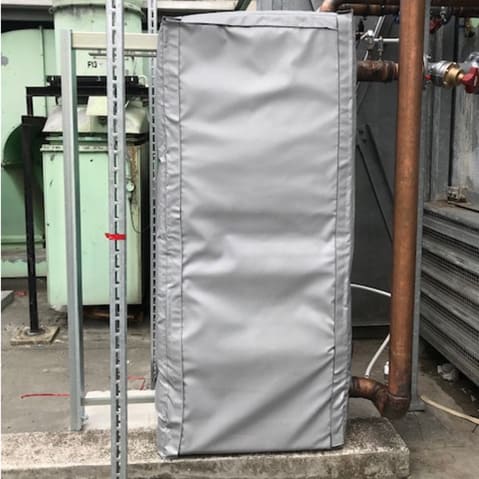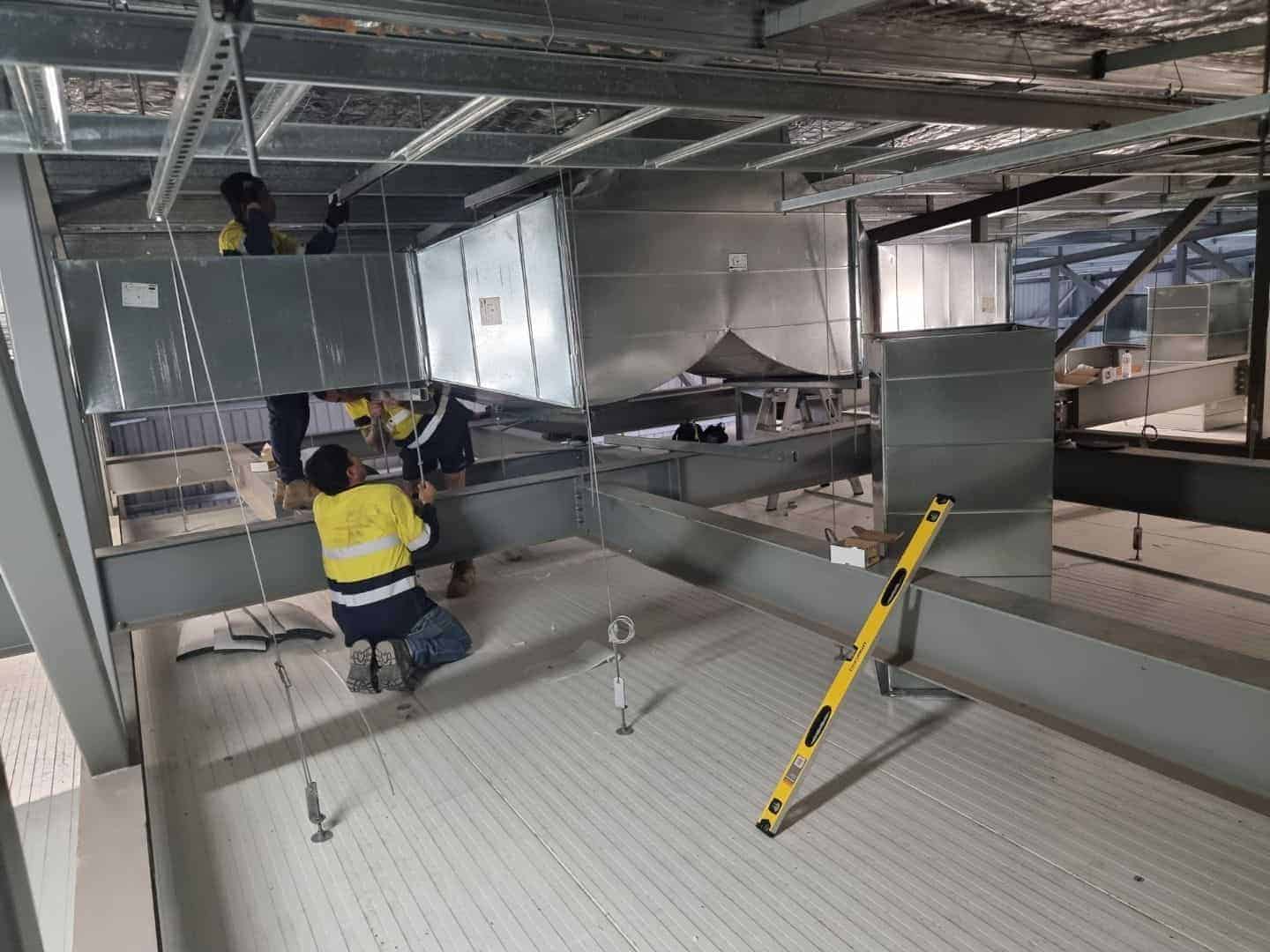Passive Fire Protection (PFP) is an essential component in the safety blueprint of industrial and commercial buildings. It’s a strategy designed to contain fires and prevent the spread of flames and smoke, ensuring the integrity and stability of structures during emergencies.
Among the many innovative fire suppression methods employed in PFP, fire spraying stands out for its efficiency and effectiveness. This technique involves applying protective materials to critical building components, such as mechanical ductwork and steel beams, to enhance their fire resistance.
Throughout this post, we will delve into the various aspects of fire spraying and highlight its significant role in bolstering the safety of buildings against fire hazards.
What is Passive Fire Protection?
Passive fire protection (PFP) is a crucial aspect of building safety which is designed to prevent the spread of fire and smoke without requiring human intervention or external power sources. In a nutshell, PFP is a set of measures incorporated into the structure of a building to enhance its ability to withstand fire, slow down the fire’s spread, and ensure the safety of its occupants.
Key components of a passive fire protection system include fire-resistant walls and fire doors, fire-resistant glass, and protective coatings applied to structural steel members. These elements are designed to contain fire and smoke to a limited area, and reduce the risk of structural collapse.
Unlike active fire protection systems, such as sprinkler systems and fire extinguishers, passive fire protection does not actively fight the fire instead focuses on containment and resistance. It provides a fundamental layer of security by ensuring that, in the event of a fire, the structure of the building can resist the flames long enough for occupants to safely evacuate and for emergency services to respond. This aspect of fire safety is an integral part of the building code and is essential for the overall fire protection strategy of any structure.
Compliance and Standards

Navigating through the maze of fire safety standards and regulations is essential for ensuring the integrity of passive fire protection systems. These standards, which vary by region, outline the requirements for fire resistance and safety features in buildings. They are designed to ensure that all passive fire protection elements, such as fire walls or any other kind of fire-rated barrier, meet a certain threshold of fire resistance.
Ensuring compliance with these regulations is a crucial step in the installation of passive fire protection systems. The application of professional fire spraying coats, for instance, must adhere to current fire code guidelines to ensure they provide the intended level of protection.
Certified professionals, like us here at Advanced Insulation and Fabrications, play a pivotal role in the installation and maintenance of passive fire protection systems. Our expertise is essential in ensuring that all passive fire protection elements are correctly installed and maintained. This expertise ensures that buildings not only comply with the latest fire safety standards, but also provide effective protection in the event of a fire.
Fire Spraying for Mechanical Ductwork and Steel Beams
Fire spraying is an advanced technique used in both passive and active fire safety systems. This method involves applying a specialised coating, typically made of intumescent or cementitious materials, onto surfaces such as mechanical ductwork and steel beams. These materials are designed to expand when exposed to high temperatures, forming a protective barrier against fire.
The benefits of fire spraying are significant, and include:
- Fire Resistance Enhancement: The coating significantly improves the fire resistance of treated surfaces, helping to contain fire and prevent its spread.
- Structural Integrity Preservation: By protecting steel beams and ductwork from the intense heat of a fire, their structural integrity is maintained, which is crucial for the overall safety of the building.
- Compliance with Safety Standards: Using fire spraying ensures that buildings meet the stringent fire safety requirements set by building codes and regulations.v
In-Depth Application: Mechanical Ductwork
Mechanical ductwork in buildings plays a critical role in air circulation and temperature regulation. Protecting this ductwork from fire is crucial, as damage can significantly impact a building’s functionality and safety. The challenge in ductwork fire protection lies in its extensive and often complex network throughout a building.
The fire spraying process for ductwork involves:
- Thorough preparation of the duct surface.
- Application of fire-resistant coatings, ensuring even coverage.
- Regular inspections post-application to ensure ongoing protection and compliance with fire safety standards.
By treating ductwork with fire-resistant materials, we enhance the safety of the entire building, ensuring that critical ventilation paths remain functional even in the event of a fire.
In-Depth Application: Steel Beams
Steel beams are integral to a building’s structure but are highly vulnerable to high temperatures, which can weaken them and compromise the building’s stability. The application of fire spraying on steel beams is, therefore, an essential step in building safety.
Key points in the fire spraying process for steel beams include:
- Selection of Suitable Materials: Choosing the right fire-resistant coating that will expand to protect the steel at high temperatures.
- Application Techniques: Ensuring even and thorough coverage of the beams for optimal protection.
- Regular Inspections and Maintenance: To maintain the effectiveness of the fire protection over time.
By implementing these techniques, we can significantly enhance the fire resistance of steel beams, safeguarding the building’s structural integrity and providing peace of mind that all necessary safety measures are in place.
Maintenance and Inspection
As mentioned, regular maintenance and inspection are key to ensuring the continued effectiveness of passive fire protection systems. Over time, the integrity of fire protection elements can be compromised due to environmental factors, building alterations, or wear and tear.
The importance of regular maintenance of fire sprayed surfaces, such as those on structural steel members, cannot be overstated. These coatings, which are vital for maintaining the fire resistance of the steel, need to be checked regularly for damage or deterioration. Inspection protocols typically involve a thorough examination of all passive fire protection elements to ensure they remain in good condition and function as intended.
Some tips for maintenance and inspection include:
- Regularly scheduled inspections by certified professionals.
- Immediate repair or replacement of any damaged elements.
- Keeping a detailed log of all maintenance and inspection activities.
- Ensuring that any modifications to the building structure are assessed for their impact on existing fire protection measures.
Enhance Your Building Safety with Advanced Fire Spraying Solutions
To wrap it up, Passive Fire Protection and fire suppression systems are a cornerstone of building safety, as they play a vital role in safeguarding lives and property.
The application of fire spraying, which is a key method in PFP, significantly enhances the fire resistance of critical building components, offering an additional layer of security. Its effectiveness in preserving structural integrity and ensuring compliance with fire safety standards cannot be overstated.
At Advanced Insulation & Fabrications, we specialise in providing top-tier fire spraying applications by offering customised solutions tailored to the unique needs of our client’s industrial and commercial establishments. Our commitment to safety and quality is unwavering, and we invite you to experience our expertise and dedication.
For unparalleled fire protection solutions that cater to your specific requirements, don’t hesitate to reach out to us. We’re here to ensure your peace of mind with our reliable and efficient services.

